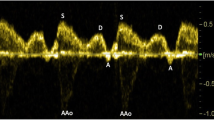Abstract
Objective
To establish reference ranges for ductus venosus waveform indices in the Japanese population.
Methods
In this retrospective cross-sectional study, 791 singleton fetuses of healthy Japanese couples were examined from January 2004 to January 2008. Reference ranges for ductus venosus waveform indices were constructed from cross-sectional data obtained at between 18 and 41 weeks of gestation.
Results
With a success rate of 84%, a total of 667 measurements in 791 women were eligible for analysis. The median pulsatility index (PI) of fetal ductus venosus decreased from 0.54 at 18 weeks of gestation to 0.30 at 41 weeks of gestation. The median end-diastolic velocity/peak systolic velocity (a/S) of the ductus venosus increased from 0.56 at 18 weeks of gestation to 0.76 at 41 weeks of gestation.
Conclusions
In this study, we established reference ranges for the PI and a/S of the ductus venosus in the Japanese population, which differed slightly from other published reference data. The results will be useful for further studies to determine the validity of the clinical importance of the ductus venosus for at-risk fetuses.








Similar content being viewed by others
References
Rizzo G, Capponi A, Arduini D, Romanini C. Ductus venosus velocity waveforms in appropriate and small for gestational age fetuses. Early Hum Dev. 1994;39:15–26.
Rudolph AM. Hepatic and ductus venosus blood flows during fetal life. Hepatology. 1983;3:254–8.
Kiserud T. Fetal venous circulation—an update on fetal hemodynamics. J Perinat Med. 2000;28:90–6.
Haugen G, Kiserud T, Godfrey K, Crozier S, Hanson M. Portal and umbilical venous blood supply to the liver in the human fetus near term. Ultrasound Obstet Gynecol. 2004;24:599–605.
Kiserud T, Eik-Nes S, Blass HG, Hellevik LR. Ultrasonographic velocimetry of the fetal ductus venosus. Lancet. 1991;338:1412–4.
Baschat AA, Guclu S, Kush ML, Gembruch U, Weiner CP, Harman CR. Venous Doppler in the prediction of acid-base status of growth-restricted fetuses with elevated placental blood flow resistance. Am J Obstet Gynecol. 2004;191:277–84.
Hecher K, Snijders R, Campbell S, Nicolaides KH. Fetal venous, intracardiac, and arterial blood flow measurements in intrauterine growth retardation: relationship with fetal blood gases. Am J Obstet Gynecol. 1995;173:10–5.
Hecher K, Campbell S, Snijders R, Nicolaides K. Reference ranges for fetal venous and atrioventricular blood flow parameters. Ultrasound Obstet Gynecol. 1994;4:381–90.
Hofstaetter C, Gudmundsson S, Dubiel M, Marsál K. Ductus venosus velocimetry in high-risk pregnancies. Eur J Obstet Gynecol Reprod Biol. 1996;70:135–40.
Senat MV, Schwarzler P, Alcais A, Ville Y. Longitudinal changes in the ductus venosus, cerebral transverse sinus and cardiotocogram in fetal growth restriction. Ultrasound Obstet Gynecol. 2000;16:19–24.
Breeze AC, Lees CC. Prediction and perinatal outcomes of fetal growth restriction. Semin Fetal Neonatal Med. 2007;12:383–97.
Baschat AA. Doppler application in the delivery timing of the preterm growth-restricted fetus: another step in the right direction. Ultrasound Obstet Gynecol. 2004;23:111–8.
Hui L, Challis D. Diagnosis and management of fetal growth restriction: the role of fetal therapy. Best Pract Res Clin Obstet Gynaecol. 2008;22:139–58.
Huisman TWA, Stewart PA, Wladimiroff JW. Ductus venosus blood flow velocity waveforms in the human fetus: a Doppler study. Ultrasound Med Biol. 1992;18:33–7.
De Vore GR, Horenstein J. Ductus venosus index: a method for evaluating right ventricular preload in the second-trimester fetus. Ultrasound Obstet Gynecol. 1993;3:338–42.
Oepkes D, Vandenbussche FP, Van Bel F, Kanhai HH. Fetal ductus venosus blood flow velocities before and after transfusion in red-cell alloimmunized pregnancies. Obstet Gynecol. 1993;82:237–41.
Nakata M. Doppler-velocity waveforms in ductus venosus in normal and small-for-gestational-age fetuses. J Obstet Gynaecol Res. 1996;22:489–96.
Bahlmann F, Wellek S, Reinhardt I, Merz E, Steiner E, Welter C. Reference values of ductus venosus flow velocities and calculated waveform indices. Prenat Diagn. 2000;20:623–34.
Baschat AA. Relationship between placental blood flow resistance and precordial venous Doppler indices. Ultrasound Obstet Gynecol. 2003;22:561–6.
Axt-Fliedner R, Wiegank U, Fetsch C, Friedrich M, Krapp M, Georg T, Diedrich K. Reference values of fetal ductus venosus, inferior vena cava and hepatic vein blood flow velocities and waveform indices during the second and third trimester of pregnancy. Arch Gynecol Obstet. 2004;270:46–55.
Kessler J, Rasmussen S, Hanson M, Kiserud T. Longitudinal reference ranges for ductus venosus flow velocities and waveform indices. Ultrasound Obstet Gynecol. 2006;28:890–8.
Kiserud T, Eik-Nes SH, Hellevik LR, Blaas HG. Ductus venosus—a longitudinal Doppler velocimetric study of the human fetus. J Matern Fetal Investig. 1992;2:5–11.
Royston P, Wright EM. How to construct ‘normal ranges’ for fetal variables. Ultrasound Obstet Gynecol. 1998;11:30–8.
Bland JM, Altman DG. Applying the right statistics: analyses of measurement studies. Ultrasound Obstet Gynecol. 2003;22:85–93.
Bland JM, Altman DG. Statistical methods for assessing agreement between two methods of clinical measurement. Lancet. 1986;1:307–10.
Author information
Authors and Affiliations
Corresponding author
Additional information
An erratum to this article is available at http://dx.doi.org/10.1007/s10396-013-0473-0.
About this article
Cite this article
Takahashi, Y., Ishii, K., Honda, K. et al. Establishment of reference ranges for ductus venosus waveform indices in the Japanese population. J Med Ultrasonics 37, 201–207 (2010). https://doi.org/10.1007/s10396-010-0269-4
Received:
Accepted:
Published:
Issue Date:
DOI: https://doi.org/10.1007/s10396-010-0269-4




